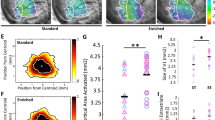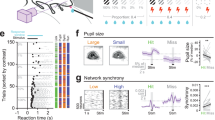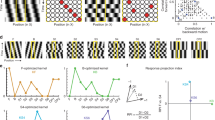Abstract
EARLY visual experience is important for the development of vision in kittens. The response specificity of visual neurones for different environmental features can be affected by selective visual exposure to those features, and leads to long term changes in visual capacities1–4. Modification occurs only if the kitten is exposed selectively during the first three months of life. The peak period of sensitivity for “tuning” seems to occur between days 28 and 35, and thereafter declines rapidly; by the end of the second month, neuronal connections are less readily modifiable5–6. The peak of the sensitive period coincides with the clearance of the ocular media7, the beginnings of adequate locomotor control (M. S. Levine, C. D. Hull, and N. A. Buckwald, unpublished), completion of the most active phase of myelination in the optic nerve and optic tract (C. L. Moore, R. E. Kalil, and W. A. Richards, unpublished), and the period of greatest synaptic density in the visual cortex8. In the present study we show that kittens do not spontaneously seek light at this time. Rather, there is a sudden onset of light-seeking behaviour at two months of age, when the cortical contour-coding system is not very sensitive to environmental modification, and many other adult visual characteristics have already been acquired.
This is a preview of subscription content, access via your institution
Access options
Subscribe to this journal
Receive 51 print issues and online access
$199.00 per year
only $3.90 per issue
Buy this article
- Purchase on Springer Link
- Instant access to full article PDF
Prices may be subject to local taxes which are calculated during checkout
Similar content being viewed by others
References
Blakemore, C., and Cooper, G. F., Nature, 228, 477–478 (1970).
Hirsch, H. V. B., and Spinelli, D. N., Science, 168, 869–871 (1970).
Pettigrew, J. D., Science, 182, 599–601 (1973).
Muir, D. W., and Mitchell, D. E., Science, 180, 420–422 (1973).
Blakemore, C., and van Sluyters, R. C., J. Physiol., Lond., 237, 195–216 (1974).
Hubel, D. H., and Wiesel, T. N., J. Physiol., Lond., 206, 419–436 (1970).
Hubel, D. H., and Wiesel, T. N., J. Neurophysiol., 26, 994–1002 (1963).
Cragg, B. G., J. Comp. Neur., 160, 147–166 (1975).
Blakemore, C., and Mitchell, D. E., Nature, 246, 506–508 (1973).
Pettigrew, J. D., J. Physiol., Lond., 237, 49–74 (1974).
Dodwell, P. C., Psychol. Rev., 71, 148–159 (1964), Visual Pattern Recognition (Holt, New York, 1970).
Author information
Authors and Affiliations
Rights and permissions
About this article
Cite this article
DODWELL, P., TIMNEY, B. & EMERSON, V. Development of visual stimulus-seeking in dark-reared kittens. Nature 260, 777–778 (1976). https://doi.org/10.1038/260777a0
Received:
Accepted:
Published:
Issue Date:
DOI: https://doi.org/10.1038/260777a0
This article is cited by
Comments
By submitting a comment you agree to abide by our Terms and Community Guidelines. If you find something abusive or that does not comply with our terms or guidelines please flag it as inappropriate.



